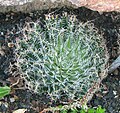Haworthia: Difference between revisions
m Dating maintenance tags: {{Citation needed}} |
adding species |
||
| Line 8: | Line 8: | ||
''[[Haworthia angustifolia]]''<br/> |
''[[Haworthia angustifolia]]''<br/> |
||
''[[Haworthia arachnoidea]]''<br/> |
''[[Haworthia arachnoidea]]''<br/> |
||
''[[Haworthia aspera]]''<br/> |
|||
''[[Haworthia attenuata]]''<br/> |
''[[Haworthia attenuata]]''<br/> |
||
''[[Haworthia bolusii]]''<br/> |
|||
''[[Haworthia chloracantha]]''<br/> |
|||
''[[Haworthia coarctata]]''<br/> |
''[[Haworthia coarctata]]''<br/> |
||
''[[Haworthia comptoniana]]''<br/> |
|||
''[[Haworthia cooperi]]''<br/> |
''[[Haworthia cooperi]]''<br/> |
||
''[[Haworthia cummingii]]''<br/> |
|||
''[[Haworthia cymbiformis]]''<br/> |
''[[Haworthia cymbiformis]]''<br/> |
||
''[[Haworthia emelyae]]''<br/> |
''[[Haworthia emelyae]]''<br/> |
||
| Line 16: | Line 21: | ||
''[[Haworthia glabrata]]''<br/> |
''[[Haworthia glabrata]]''<br/> |
||
''[[Haworthia glauca]]''<br/> |
''[[Haworthia glauca]]''<br/> |
||
''[[Haworthia helmiae]]''<br/> |
|||
''[[Haworthia limifolia]]''<br/> |
''[[Haworthia limifolia]]''<br/> |
||
''[[Haworthia maculata]]''<br/> |
|||
''[[Haworthia magnifica]]''<br/> |
|||
''[[Haworthia maraisii]]''<br/> |
''[[Haworthia maraisii]]''<br/> |
||
''[[Haworthia maughanii]]''<br/> |
|||
''[[Haworthia maxima]]''<br/> |
|||
''[[Haworthia mirabilis]]''<br/> |
''[[Haworthia mirabilis]]''<br/> |
||
''[[Haworthia pehlemanniae]]''<br/> |
|||
''[[Haworthia pygmaea]]''<br/> |
''[[Haworthia pygmaea]]''<br/> |
||
''[[Haworthia reinwardtii]]''<br/> |
''[[Haworthia reinwardtii]]''<br/> |
||
''[[Haworthia retusa]]''<br/> |
''[[Haworthia retusa]]''<br/> |
||
''[[Haworthia semiviva]]''<br/> |
|||
''[[Haworthia springbokvlaktensis]]''<br/> |
|||
''[[Haworthia truncata]]''<br/> |
''[[Haworthia truncata]]''<br/> |
||
''[[Haworthia turgida]]''<br/> |
''[[Haworthia turgida]]''<br/> |
||
Revision as of 03:32, 5 December 2012
Haworthia is a genus of flowering plants within the family Xanthorrhoeaceae, subfamily Asphodeloideae.[1] They are small (typically 20 cm (8 in) high) solitary or clump-forming and endemic to South Africa. Some species have firm, tough leaves, usually dark green in color, whereas other are soft and semi-translucent. Their flowers are small, white and very similar between species. But their leaves show wide variations even within one species.
The classification of the flowering plant subfamily Asphodeloideae is weak and concepts of the genera are not well substantiated.[citation needed] Haworthia is similarly a weakly contrived genus consisting of three distinct groups: sub-genera Haworthia, Hexangularis, and Robustipedunculares.[citation needed] Related genera are Aloe, Gasteria and Astroloba and intergeneric hybrids are known.
The genus Haworthia is named after the botanist Adrian Hardy Haworth. Bayer recognizes approximately 61 species whereas other taxonomists are very much less conservative (1999, Haworthia Revisited, Umdaus Press). The species are endemic to South Africa, Swaziland, Namibia and Maputoland. The plants are small, forming rosettes of leaves from 3 cm (1.2 in) to exceptionally 30 cm (12 in) in diameter. These rosettes are usually stemless but in some species stems reach up to 50 cm (20 in).
Their flowers are small, white and very similar between species. There are differences in the flowers of the three sub-genera that botanists have curiously considered inconsequential although the differences between species in the same subgenus definitely are. The roots, leaves and rosettes do demonstrate some generic differences while wide variations occur even within one species. Because of their horticultural interest, the taxonomy has been dominated by amateur collectors and the literature is rife with misunderstanding of what the taxa actually are or should be.[citation needed]
There is widespread special collector interest but some species such as Haworthia attenuata and Haworthia cymbiformis, are fairly common house and garden plants. Haworthia species reproduce both through seed and through budding, or offsets. Certain species or clones may be more successful or rapid in offset production, and these pups are easily removed to yield new plants once a substantial root system has developed on the offshoot. Less reliably, the plants may also be propagated through leaf cuttings, and in some instances, through tissue culture.[citation needed]
-
Haworthia arachnoidea var. namaquensis, Habitat Richtersveld
-
Haworthia cooperi var. pilifera
-
Haworthia emelyae var. comptoniana
-
Haworthia truncata hybrid.
-
Haworthia venosa ssp. tessellata
-
Haworthia sp.
-
× Gasterhaworthia 'Royal Highness'
References
- ^ Stevens, P.F. (2001 onwards), Angiosperm Phylogeny Website: Asparagales: Asphodeloideae
{{citation}}: Check date values in:|year=(help)CS1 maint: year (link)

















